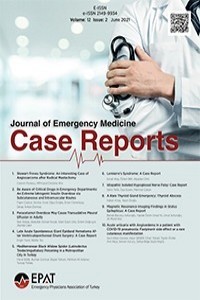Splenik İnfarkt Gelişen Atrial Fibrilasyonlu Bir Olgu
Atriyal fibrilasyon, karın ağrısı, splenik infarkt
A Case of Splenic Infarction Developing Atrial Fibrillation
Atrial fibrillation, abdominal pain, splenic infarction,
___
- Jaroch TM, A. Broughan T, Hermannn ER: The natural history of splenic infarction. Surgery 1986; 100: 743-50.
- Antopolsky M, Hiller N, Salameh S,Goldshtein B, Stalnikowicz R. Splenic infarction: 10 years of experience. Am J Emerg Med 2009; 27: 262-5. [CrossRef]
- Ebert EC, Nagar M, Hagspiel KD. Gastrointestinal and hepatic complications of sickle cell disease. Clin Gastroenterol Hepatol 2010; 8: 483-9. [CrossRef]
- Park MY, Kim JA, Yi SY, Chang SH, Um TH, Lee HR. Splenic infarction in a patient with autoimmune hemolytic anemia and protein C deficiency. Korean J Hematol 2011; 46: 274-8. [CrossRef]
- Görg C, Seifart U, Görg K. Acute, complete splenic infarction in cancer patient is associated with a fatal outcome. Abdomen Imaging 2004; 29: 224-7. [CrossRef]
- Menke J, Luthje L, Kastrup A, Larsen J. Thromboembolism in atrial fibrillation. Am J Cardiol 2010; 105: 502-10. [CrossRef]
- Lawrence YR, Pokroy R, Berlowitz D, et al. Spleni cinfarction: an update on William Osler’s observations. Isr Med Assoc J 2010; 12: 362-5.
- Pachter HL, Hofstetter SR, Elkowitz A. Traumaticcysts of the spleen-the role of cystectomy and splenic preservation: experience with seven consecutive patients. J Trauma Sep 1993; 35: 430-6. [CrossRef]
- Robertson F, Leander P, Ekberg O. Radiology of the spleen. European Radiol 2001; 11: 80-95. [CrossRef]
- Yayın Aralığı: 4
- Başlangıç: 2010
- Yayıncı: Alpay Azap
Splenik İnfarkt Gelişen Atrial Fibrilasyonlu Bir Olgu
Murat YALÇIN, Hatice YILMAZ, Adnan KIRCI, Muammer KARADENİZ, Hasan ANIK, Halil UZUNEL, Talat TAVLI, Güray ÖNCEL, Ali SAKLAMAZ, Nuh YILMAZ
Brusellaya Bağlı Sakroiliak Abse
Ventriküloperitoneal Şantlı Bir Hastada Ketiapin Tedavisi ile İlişkili Nöroleptik Malign Sendrom
Yılmaz ZENGİN, Mustafa İÇER, Ercan GÜNDÜZ, Ayhan ÖZHASENEKLER, Recep DURSUN, Murat ORAK, Cahfer GÜLOĞLU
Kronik Karaciğer Hastalığı Olan Olguda Cilt altı Enfekte Hematom ve Pnömomediastinum
Mehmet Ali ASLANER, Mehmet Ali KARACA
Selçuk COŞKUN, Yücel YÜZBAŞIOĞLU, Havva Şahin KAVAKLI, Alp SENER, Ferhat ICME, Erkut EROL
Aykut SARITAŞ, Mehmet KORKMAZ, Muhammed Murat KURNAZ
Spinal Anestezi Girişimine Bağlı Baş Ağrısı Olduğu Düşünülen Bir Hastada Serebral Venöz Tromboz
Fatma DOĞANAY, Ferudun KOYUNCU
Oral Antikoagülan Tedaviye Sekonder Spontan Hemotoraks
Akkan AVCİ, Mürsel KOÇER, Müge GÜLEN, Mehmet Oğuzhan AY, Ferhat ICME, Begüm Şeyda AVCİ
Elin Yüksek Basınçlı Likit Kristal Enjeksiyon Yaralanması: Olgu Sunumu
Melis EFEOĞLU, Serkan Emre EROĞLU, Serhad ÖMERCİKOĞLU, Haldun AKOĞLU, Özge ONUR, Arzu DENİZBAŞI
